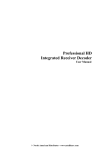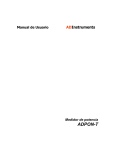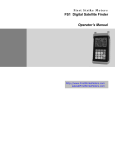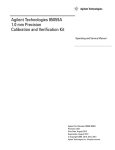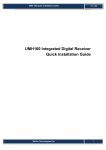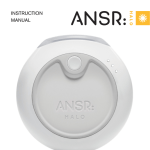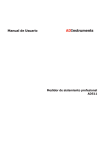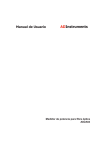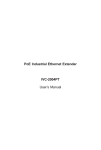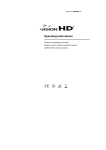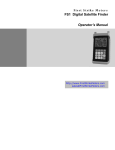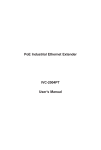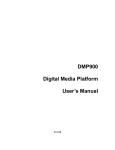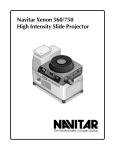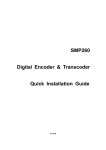Download AD-160 HD Integrated Receiver Decoder
Transcript
AD-160 HD Integrated Receiver Decoder User Manual AD INSTRUMENTS Http://www.abacantodigital.com Table of Content Safety ......................................................................................................................................................... 1 Reference ................................................................................................................................................... 2 Features ...................................................................................................................................................... 3 Introduction ................................................................................................................................................ 4 FRONT PANEL ................................................................................................................................... 4 REAR PANEL ..................................................................................................................................... 5 TUNER IN AND ASI OUT .................................................................................................................... 6 TUNER IN AND IP OUT ....................................................................................................................... 6 TUNER IN AND CVBS OUT ................................................................................................................ 6 IP IN AND ASI OUT ............................................................................................................................ 7 TUNER/IP/ASI IN AND SDI OUT ........................................................................................................ 7 TUNER/IP/ASI IN AND HDMI OUT.................................................................................................... 7 SYSTEM CONNECTION DIAGRAM ..................................................................................................... 8 Front Panel Control & Operation ............................................................................................................... 9 INPUT ...............................................................................................................................................11 Sources ..................................................................................................................................... 11 Params ...................................................................................................................................... 11 OUTPUT .......................................................................................................................................... 12 Program Setup .......................................................................................................................... 12 Decoder .................................................................................................................................... 12 SDI ........................................................................................................................................... 13 Ethernet .................................................................................................................................... 13 SYSTEM .......................................................................................................................................... 14 Local Setup .............................................................................................................................. 14 Properties ................................................................................................................................. 14 Factory Setting ......................................................................................................................... 14 STATUS............................................................................................................................................ 14 Input status ............................................................................................................................... 14 Outputs status ........................................................................................................................... 14 NMS Control & Operation ....................................................................................................................... 15 LAN PARAMETERS SETTING & CONNECTION ESTABLISHMENT ....................................................... 15 Local network setting ............................................................................................................... 15 Connection ............................................................................................................................... 15 NMS MAIN INTERFACE CONFIGURATION ....................................................................................... 16 Troubleshooting ....................................................................................................................................... 24 Specifications ........................................................................................................................................... 26 Http://www.abacantodigital.com Safety To avoid electric-shock hazards, do not open the receiver; refer service to qualified personnel only. Keep the receiver away from flower vases, tubs, sinks, etc., in order to avoid damaging the equipment. Do not expose the receiver in the sunlight. And keep it away from the heat source. Do not block ventilation holes of the Receiver so that air can circulate freely. When the abnormal phenomenon occurs, cut off the power immediately. Do not touch the receiver during thunder. That might create electric shock hazards. Switch the receiver off whenever it remains out of service for an extended period. Be sure to turn the receiver off and disconnect the AC power cord before cleaning the receiver surface. If the surface is dirty, wipe clean with a cloth that has been dipped in a diluted soap water solution and wrung out thoroughly, and then wipe again with a dry cloth. Specifications and functions may be changed for improvement without notice in advance. 1 AD160 HD Integrated Receiver Decoder User Manual Reference Connect a Antenna To AD160 IRD, you can connect either a single satellite antenna directly or through converter box several antennas or LNB of multi-feed equipment. You can connect a further IRD with the IRD that has common antenna equipment to receive satellite signals. Loop Through If you wish, you can connect the same LNB to another IRD via the loop through of your digital receiver decoder. Connect one end of a coaxial cable to the LNB OUT on the IRD and connect the other end to the LNB IN on your second IRD. AD160 HD Integrated Receiver Decoder User Manual 2 Features MPEG-4 AVC (H.264) Digital compliant DVB-S2/C/T signal input support (optional) For DVB-S/S2 model, input Frequency 950-2150 MHz, Symbol Rate 2 ~ 45 Ms/s (237Ms/s for 8PSK); for DVB-T model, input Frequency 48-858 MHz, Symbol Rate 0.87 ~ 6.9 Ms/s; for DVB-C model, input Frequency 50-858 MHz, Symbol Rate 0.87 ~ 6.9Ms/s 1 Tuner Input (F-Type) and Loop-through 2 DVB Common Interfaces (CI ) for descrambling most common CA systems 1 ASI transport stream input & 2 ASI output capable of working as TS decoder IP stream input and output (optional) Broadcasting quality video and audio outputs VBI Teletext handling 2 identical SDI outputs for convenient conversion of program format AES/EBU digital audio output BNC-interfaced CVBS output with the companion of AES/EBU audio output makes better sense. HDMI output with high quality video and audio gives an audiovisual feast Full control via front panel or Ethernet port Automatic recovery for latest system configuration from unexpected power off Software upgrading via NMS 3 AD160 HD Integrated Receiver Decoder User Manual Introduction The AD160 IRD is an advanced MPEG-4 AVC (H.264) HD integrated receiver decoder with optional TS-IP mutual conversion function. It can receive signal from different program sources. Its prolific output interfaces such as IP, SDI, AES/EBU, HDMI and ASI can meet different system requirements. The AD160 also has 2 common interface slots which can decode multiple scrambled channels. It is an ideal component for either a standard SD/HD digital video or an IPTV head-end system. Front Panel LED Indicator: Power: The LED lights on when the STB is power on. Lock: The LED lights on when a channel is locked. Otherwise there is no channel locked. Alarm: The LED flickers when there is something abnormal. For example, the strength of the input signal is too weak. Display screen: Show the channel name of TV or Radio program and the configuration information. CI SLOTS: There are two CI slots for various CAS CAM (PCMCIA) modules. KEY PADS: Select Keys: To change channels, adjust volume and configure the IRD. MENU: To enter the menu and the quit function of the sub menus. OK: To confirm the operation in the setup. AD160 HD Integrated Receiver Decoder User Manual 4 Rear Panel 1. TUNER IN: Connect to a RF or IF signal. 2. TUNER OUT (LOOP OUT): Use it when connecting to another IRD. 3: ETHERNET: Network remote control. 4. ASI OUT: Output MPEG-2 or Mpeg-4 TS. 5. SDI OUT: Output the SDI Video stream. 6. ASI IN: BNC connector for TS input 7. VIDEO /AUDIO: Video signal output jack and Left/right audio output jack. 8. Cr/Cb/Y: Component output 9. HDMI: Output high quality picture and sound with one cable. 10. AES/EBU: Professional digital Audio output with XLR connector 11. TS/IP: TS stream input and output in IP format. 12. POWER SUPPLY and POWER SWITCH: 90~250V AC, 50Hz. 5 AD160 HD Integrated Receiver Decoder User Manual There are several ways of connecting the IRD to your existing Audio/TV system. We recommend using one of the following set-ups for best results: Tuner in and ASI out Tuner in and IP out Tuner in and CVBS out AD160 HD Integrated Receiver Decoder User Manual 6 IP in and ASI out Tuner/IP/ASI in and SDI out Notice: You should select one signal source from the 1, 2 and 3 option. Tuner/IP/ASI in and HDMI out Notice: You should select one signal source from the 1, 2 and 3 option. 7 AD160 HD Integrated Receiver Decoder User Manual System Connection Diagram YPbPr/CVBS HDMI AD160F SDI DVB-S/S2 Program Edit / Ad Insertion AD160CI ASI ASI ASI Digital Cable receiver DVB-C/T Multiplexer QAM Modulator ASI AD160IP IP AD160IP IP IP TS IP INTERNET Network Switch Windows Video Server AD160 HD Integrated Receiver Decoder User Manual 8 Front Panel Control & Operation This diagram is for DVB-C and DVB-T IRD 9 AD160 HD Integrated Receiver Decoder User Manual This diagram is for DVB-S and DVB-S2 IRD AD160 HD Integrated Receiver Decoder User Manual 10 Input In this menu, there are two submenus used to select the input source and configure the input parameters. They are SOURCES and PARAMS. Sources In this submenu, there are three options, TUNER, ASI and IPTV. TUNER: If you select this item, the IRD will search the signal from the tuner after configuration and exit at Params. ASI: If you select this item, the IRD will search the signal from the ASI input port. IPTV: If the signal from the IP port, you can select this item. The IRD will search channels after configuration and exit at Params. Parameters In this submenu, there are two items, they are TUNER and IPTV. If your IRD is for DVBC/T/S/S2 and IPTV, please select relative reception mode such as QAM, COFDM, QPSK and IPTV. According to different type IRD, please set different parameters. TUNER In this option, several parameters are required to setup. 1) For DVB-S/S2 (QPSK): LNB frequency: this is the LNB‟s local oscillation (LO) frequency, every LNB have one or two local oscillation frequencies which can be obtained from the LNB provider. Satellite frequency: This is the satellite down-conversion frequency, every transponder has one frequency, and you can get this parameter from the satellite programs provider. Symbol rate: Every transponder have one symbol rate, you can get this parameter from the satellite programs provider. LNB Voltage: LNB voltage is the power that supply to the LNB in order to receiver satellite signal with different polarization. Generally 18V is for horizontal while 13V is for vertical. LNB 22KHz: Generally 22K is used to control 22K Switch, typically used for LNB with double L.O in Ku band. 2) For DVB-C (QAM): you need to setup QAM model, Frequency and symbol rate. 3) For DVB-T (COFDM): you need to setup bandwidth and frequency. IPTV: When the receiver wants to receive the signal from the internet, you need to configure these parameters. For DVB-S/S2/C/T, this part is the same. Receiver: Select On or Off to open or close the IPTV function. Input Multi IP Addr: Set up the multicast IP address for receiving the IP signal. Input Multi UDP port: Set up the UDP port for receiving the IP signal. Input Protocol: Default setting. IP Board IP Address: Default setting. IP Board SubNetMask: Default setting. 11 AD160 HD Integrated Receiver Decoder User Manual IP Board MAC Address: Default setting. Notice: When two or above pieces of AD160 are working in IPTV at the same time, you’d better set different ‘IP Board IP Address’ and ‘IP Board SubNetMask’ for each equipment. Output In this menu, there are three submenus including:Program Setup, Decoder and Ethernet. Program Setup In this option, all the programs received will be list. By changing the program‟s status, you can determine whether to transmit the program or appoint a CI Slot to descramble the scrambled program. Bypass: Transmit the program without any disposal. CI slot1: If the program is scrambled, you can appoint the CAM card inserted in Slot 1 to descramble it. Under this condition, the program is transmitted in default. CI solt2: If the program is scrambled, you can appoint the CAM card inserted in Slot 2 to descramble it. Under this condition, the program is transmitted in default. Delete: Any program you don‟t want to transmit can be forbidden by selecting this status. Decoder In this menu, there are three items: Program List, Video and Audio. Program List: All the programs received by the receiver will be list here, and you can select the program played via AV interface. Video: Configure the video parameter Video standard: in this item, you can select video standard including Auto, SECAM, NTSC and PAL. Screen Mode: set the screen aspect ratio in this item, it includes Auto, 4:3Full, 16:9Full. DVB subtitle Lang: English only EBU subtitle Lang: English only Fail Mode: include Black Screen and Still Screen. Black screen: when the receiver lost the signal, keep the screen black. Still screen: when the receiver lost the signal, keep the last picture on the screen. AD160 HD Integrated Receiver Decoder User Manual 12 Video Format: set the video format in this item, it includes: Auto, 576 I, 720 P and 1080 I. Audio: Configure the audio parameter Audio:0-99 Audio mode: include Stereo, Left, Right, Mono, Dual Audio Language: Select different audio language. SDI The SDI output format is „Auto‟ which means one audio channel is embeded in the SDI video output stream and you can‟t change it here. Ethernet When select the IP port as the output, you need to setup some parameters in this submenu. There are 8 channels, and each can be used to output IP stream separately. Stream IP Addr: Default setting ( Reserve for the future) Stream Network: Default setting ( Reserve for the future) Stream Gateway: Default setting (Reserve for the future) Stream Mac Address: Default setting (Reserve for the future) Stream UDP port: Default setting (Reserve for the future) Channel 1 Param Setup: CH 1 Transmit: Select Off or On to close or open the IP channel. CH 1 Program Setup: For your operation convenience, all the input programs will be outputted via this IP channel and you can‟t add or delete programs here. CH 1 Multicast Addr: Set up the multicast IP for broadcasting the IP signal CH 1 Port: Set up the UDP or RTP port for broadcasting the IP signal CH 1 Protocol: UDP/RTP CH 1 TS Packets: Configuration range is 1—7 (7 is recommended) CH 1 Time to Live: Configuration range is 1-255 (8 is recommended) Ch 1 Type of Service: It includes Normal, Min delay, Monetary Cost, Max reliability, Max Throughput Channel 2 Param Setup: CH 2 Transmit: Select Off or On to close or open the IP channel. CH 2 Program Setup: Select Add to add the program to the IP channel, and select Delete to delete the program in the IP channel. CH 2 Multicast Addr: Set up the multicast IP for broadcasting the IP signal CH 2 Port: Set up the UDP or RTP port for broadcasting the IP signal CH 2 Protocol: UDP/RTP CH 2 TS Packets: Configuration range is 1—7 (7 is recommended) CH 2 Time to Live: Configuration range is 1-5 (5 is recommended) Ch 2 Type of Service: It includes Normal, Min delay, Monetary Cost, Max reliability, Max Throughput, Channel 3/ 4/ 5/ 6/ 7/ 8 Param Setup: The same as Channel 2 13 AD160 HD Integrated Receiver Decoder User Manual System Under this menu, there are three submenus including Local Setup, Properties and Factory Setting. Local Setup IP address: Local IP setting for connecting to the server. This IP and the server‟s IP should be in the same section. Network Mask: Network Mask setting for connecting to the server. Gateway: Gateway setting for connecting to the server. Trap IP address: This IP should be the same as the server‟s IP, before connection, it will verify the server‟s IP, if they are the same, the connection will be allowed. Properties Mac Address: Query the receiver‟s Mac Address. HW Version: Query the receiver‟s hardware version. SW Version: Query the receiver‟s software version. Factory Setting Take the receiver back to factory setting. Status There are two submenus under this menu: Input status and output status. Input status Query the input status, lock or unlock. Outputs status Decoder: In this item you can check the programs PMT, PN, AV, Video, Audio status. CI: Check two CI status. AD160 HD Integrated Receiver Decoder User Manual 14 NMS Control & Operation Except using the front panel to configure and operate the equipment, AD160 also supplies the network management function. When you get the equipment, there should be a CD containing the network management software. If you want to control and operate the equipment via the network management software, please copy the software from the CD to your server (Computer). LAN parameters setting & connection establishment Before logging on the equipment, you should use the front panel to configure the local network setting. Local network setting Let‟s take an example to explain how to configure the local network for connection. We assume the server‟s IP is 192.168.1.2, network mask is 255.255.255.0 and gateway is 198.168.1.1. All these parameters in the equipment should be: IP address: Local IP setting for connecting to the server. This IP and the server‟s IP should be in the same section. For example is can be 192.168.1.x, x can be 3 to 254. Network Mask: Network Mask setting for connecting to the server. It should be the same as server‟s. 255.255.255.0. Gateway: Gateway setting for connecting to the server. It should be the same as server‟s. 198.168.1.1 Trap IP address: This IP should be the same as the server‟s IP. Before connection, it will verify the server‟s IP, if they are the same, the connection will be allowed. It should be 192.168.1.2. Connection Connect the server and equipment via Ethernet port with an Ethernet cable before running the network management software on the server. Then log on the NMS and enter the user name and password, the default user name and password both are “admin”, just as the following picture. Notice: this NMS can manage several pieces of AD160 at the same time, as long as these equipments are connected to the server via the Network Switch. Now we take one piece of AD160 for example to illustrate the operation. 15 AD160 HD Integrated Receiver Decoder User Manual NMS Main Interface Configuration After logging in successfully, it‟ll search the AD160 which is connected to the server and display it in the left side as below automatically. After logging on the AD160, you can see seven pages within every IRD, they are: Main Board, Audio/Video, Status, IP Board, Upgrade, System and Advance. Except that, there‟re two parts used to display some correlative information, just as the following picture. AD160 HD Integrated Receiver Decoder User Manual 16 Main Board SOURCES In this submenu, there are three options, TUNER, ASI and IPTV. TUNER: when select this item, the receiver will search the signal from the tuner, different IRD model may have different NMS interface and operation. ASI: when select this item, the receiver will search the signal from the ASI input port. IPTV: when the signal from the IP port, you can select this item. Tuner selection In this item, you can set the parameters according to different tuner model, DVB-S (QPSK), DVB-S2 (8PSK), DVB-C (QAM) and DVB-T (COFDM). According to your IRD model select correct tuner. Then setup parameters of frequency, symbol rate, LNB Voltage, LNB 22KHz, QAM model, bandwidth and so on. You can get these parameters from your program provider. CI MultiDecrypt Mode MultiPMT: it‟s the default option, you needn‟t change it generally. CombinePMT: if your CAM can‟t decrypt programs normally, you can try to select it. Program List Refresh: update the programs from the input signal. Default: get all the programs‟ Operation back to „Bypass‟. In the programs list box, all the received programs will be list. There are three items 17 AD160 HD Integrated Receiver Decoder User Manual providing the programs information: Number, Name and Operation. Let‟s take Channel [V] (NO.21) for example to explain how to edit the programs. Click the program which you want to edit (in the picture, it is Channel [V], NO.21), and then this program will be highlighted in blue, program number will show in “Program Number” item. Then click the down list menu in the “program operation” item to select the status you need. Explain: Bypass: Transmit the program without any disposal. CI slot1: If the program is scrambled, you can appoint the CAM card inserted in Slot 1 to descramble it. Under this condition, the program is transmitted in default. CI solt2: If the program is scrambled, you can appoint the CAM card inserted in Slot 2 to descramble it.. Under this condition, the program is transmitted in default. Delete: Any program you don‟t want to transmit can be forbidden by selecting this status. Play List In this box, select the programs you want to play via AV interface, and then click “SendData” button to save the parameters, the programs you select will be played. Playing program The information of the program played currently will appear here, such as PMT PID, Video PID, Audio PID and so on. Notice: After setting all the parameters for each page (including the following 6 pages), you should press ‘SendData’ to enable the new parameters. Audio/Video AD160 HD Integrated Receiver Decoder User Manual 18 Video Video standard: in this item, you can select video standard including Auto, SECAM, NTSC and PAL. Screen Mode: set the screen aspect ratio in this item, it includes Auto, 4:3 Full, 16:9 Full. DVB subtitle Language: English only EBU subtitle Language: English only Video Fail Mode: include Black Screen and Still Screen. Black screen: when the receiver lost the signal, keep the screen black. Still screen: when the receiver lost the signal, keep the last picture on the screen. Video Format: includes Auto, 576 I, 720 P and 1080 I. Audio Audio Level:0-99 Audio mode: include Stereo, Left, Right, Mono, Dual Audio Language: Select different audio language. SDI Setup They are not valid temporarily, and one audio channel is embedded in the SDI video output stream automatically. Status 19 AD160 HD Integrated Receiver Decoder User Manual This page is used to display the status of CI Slot, total input rate, valid input rate, BER (it‟ll won‟t affect the normal function in fact now) and tell you whether the input signal is locked or not. IP Board This page is used to configure the parameters for the IP function including „IP Receiver‟, „Transmitter‟ and „Program List‟. Notice: when you enable the ‘IP Receiver’, you must set the right ‘MultiCastAddress’ and ‘MultiCastPort’. For example AD160_A AD160_B Role IP Transmitter IP Receiver Address IPDestAddress:227.40.50.60 MultiCastAddress :227.40.50.60 Port UDPDestPort: 1234 MultiCastPort : 1234 AD160 HD Integrated Receiver Decoder User Manual 20 IP Receiver Enable: When the programs are from IP source, select on. Protocol: Optional UDP and RTP according to your IP source. Enablechannel: When the programs are from IP source, select on. MulticastAddress: Set up the multicast IP address for receiving the IP signal. MulticastPort: Set up the UDP port for receiving the IP signal. Other parameters: Default setting. Transmitter ChannelSelect: Set up the IP channel number where you want to transmit programs. EnableChannel: Enable or disable the IP channel. Protocol: Optional UDP or RTP according your requirement. EncapNum TSPackts: Configuration range is 1—7. (Number 7 is recommended). TypeOfService: It includes Normal, Min delay, Monetary cost, Max reliability, Max Throughput,. TimeToLive: Configuration range is 1-255. (Number 8 is recommended). IPDestAddress: Set up the IP channel‟s multicast IP address for broadcasting the IP signal. UDPDestPort: Set up the UDP port for the IP signal. Other parameters: Default setting. Note: 1. IP Channel 1 transmits all the input programs, which means you can’t add or delete programs on IP channel 1. For other IP channels, you can edit the output program as 21 AD160 HD Integrated Receiver Decoder User Manual you wish by selecting it and pressing ‘Change’ button. 2. after setting all the parameters for one IP channel, you should press ‘SaveThisChannelParameter’ to save the setting of this channel. Program list In this part, you can see the information of the programs which is in the selected channel. You can determine which program will be transmitted by changing the status of „Operation‟ in the list. Upgrade: It‟s convenient to upgrade the latest software via this NMS. Click „Select File‟ button, select a desired document and click „Start‟ the NMS will upgrade for AD160 automatically. You should restart the NMS after the upgrade. If the upgrade is successful, a message „Upgrade succeed! Please restart the software!‟will pop up, and then the AD160 will restart automatically. System System IP address: Local IP setting for connecting to the server. This IP and the server‟s IP should be in the same section. Network Mask: Network Mask setting for connecting to the server. Gateway: Gateway setting for connecting to the server. AD160 HD Integrated Receiver Decoder User Manual 22 Mac Address: Query the receiver‟s Mac Address. Factory setting Get all the parameters in the equipment back the default parameters. Advance This option is designed for recording the information about the equipment, however, the option is not available now and reserved for the future. 23 AD160 HD Integrated Receiver Decoder User Manual Troubleshooting Problem Possible causes The display on the front panel does not light up. No power. What to do Check that the main cable is plugged into the power socket. The unit is in standby mode Check the output connection or The front panel red light is or no output connection. Press the standby button. on. AV has no output. TV is not in AV mode. Set TV in AV mode. Check the cable connections, No cable connection or the LNB and other equipment program does not exist in connected between the LNB the current satellite. and the STB, and /or adjust the dish. No or bad signal. Bad picture / Blocking error. Problem The satellite dish is not facing the satellite. Adjust the dish. Check the signal level in the antenna setup menu. The satellite dish is not facing the satellite. Adjust the dish. Signal is too strong. Connect a signal attenuator to the LNB input. Signal is too weak. Change to a larger dish. LNB noise figure is too high. Change to a LNB with a lower noise figure. The LNB is defect. Change the LNB. Possible causes Signal is good. But No picture and no audio. What to do The picture and audio are Change to a FTA channel. scrambled. AD160 HD Integrated Receiver Decoder User Manual 24 There is interference on your digital satellite channel. The system is connected with RF leads and the Change the receiver output output channel of the channel to a more suitable receiver interferes with an channel. existing terrestrial channel or video signal. IP stetting Check the PC IP and equipment IP Cable is not good Make sure the cable is good one and connect well. Network remote can not connect Make sure that ASI output No output on ASI or output cable connect with the output BNC Connection loosing. unstable. port tightly. Don‟t select decrypted Select decrypted programs to programs or select be correctly. incorrectly. CAM Modular Error. Change for another CAM. Smart Card no right. Contact the content provider. Cannot Decrypt Programs. Incorrect insertion of CAM Correctly insert CAM and or Smart card. Smart card. 25 AD160 HD Integrated Receiver Decoder User Manual Specifications QPSK(8PSK) Tuner QAM COFDM Audio Frequency Range Symbol Rate Signal Strength FEC Mode Rate Demodulation Frequency Range Symbol Rate Signal Strength QAM model Frequency Range Symbol Rate Signal Strength Bandwidth Audio Decoding Audio Mode Connectors Video Decode Video Input Bit Rate Output System Video Resolution Connectors IP/TS output IP/TS input Working condition& Physical Specification Connectors Interface Type Impedance Packet Bit rate TS Format IP output Connectors Interface Type Bit rate Power supply voltage Power consumption Temperature Humidity Size (W×D×H) Net Weight 950~2150MHz 2~45Ms/s (2-37Ms/s for 8PSK) -65~-30dBm 1/2,2/3,3/4,5/6,7/8, QPSK, 8PSK 50~858MHz 0.87~6.9Ms/s 32-105dBuv 16/32/64/128/256 48~858MHz 0.87~6.9Ms/s -92~-20dBm 6/7/8M MPEG-1 layer I & II Mono/Dual Channel/Stereo RCA (L , R), XLR(L,R), MPEG-II ISO/IEC 13818-2, Mpeg-4 AVC/H.264 <=15Mbps PAL/NTSC/SECAM 720×576 RCA (CVBS, YPbPr), HDMI, SDI BNC, RJ45 ASI, IP 75Ω 188/204 1~72Mbps Single / Multiple programs Unicast /Multicast IP stream BNC, RJ45 ASI, IP Up to 82Mbps AC: 90~250V, 50Hz/60Hz 20W(Max) 0℃~40℃ 10%~90% 42mmH×484mmW×335mmD 3.7 Kg AD160 HD Integrated Receiver Decoder User Manual 26 27 AD160 HD Integrated Receiver Decoder User Manual





























